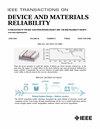原子探针层析成像观察氮化镓基激光器中老化诱导的Mg团簇
IF 2.3
3区 工程技术
Q2 ENGINEERING, ELECTRICAL & ELECTRONIC
IEEE Transactions on Device and Materials Reliability
Pub Date : 2025-03-13
DOI:10.1109/TDMR.2025.3569588
引用次数: 0
摘要
氮化镓(GaN)基激光器的发射波长从紫外到绿光,被广泛用于许多应用领域。尽管它们被广泛使用,但由于计量技术的限制,原子水平降解的综合分析仍然具有挑战性。在这项研究中,我们利用原子探针断层扫描研究了氮化镓基激光器中老化诱导的镁团簇。值得注意的是,我们在老化激光器的p型氮化铝镓(p-AlGaN)包层中发现了几纳米大小的Mg团簇,这标志着在这种情况下首次观察到这种团簇。镁团簇的存在引起包层内部的光散射和吸收,导致内部损耗增加和斜率效率降低。此外,我们的研究结果强调了原子探针断层扫描作为半导体器件进行原子级器件故障分析的有效技术的有效性。本文章由计算机程序翻译,如有差异,请以英文原文为准。
Aging-Induced Mg Cluster Observation in GaN-Based Lasers by Atom Probe Tomography
Gallium nitride (GaN)-based lasers, spanning emission wavelengths from ultraviolet to green, are widely used as light sources in many application domains. Despite their widespread usage, the comprehensive analysis of atomic-level degradation remains challenging primarily due to limitations in metrology techniques. In this study, we investigated the aging-induced magnesium (Mg) clusters in GaN-based lasers utilizing atom probe tomography. Notably, we have identified Mg clusters of several nanometers in size within the p-type aluminum gallium nitride (p-AlGaN) cladding layer of aged lasers, marking the first observation of such clusters in this context. The presence of Mg clusters induces light scattering and absorption within the cladding layer, contributing to an increase in internal loss and a decrease in slope efficiency. Furthermore, our findings underscore the efficacy of atom probe tomography as a potent technique for conducting atomic-level device failure analysis of semiconductor devices.
求助全文
通过发布文献求助,成功后即可免费获取论文全文。
去求助
来源期刊

IEEE Transactions on Device and Materials Reliability
工程技术-工程:电子与电气
CiteScore
4.80
自引率
5.00%
发文量
71
审稿时长
6-12 weeks
期刊介绍:
The scope of the publication includes, but is not limited to Reliability of: Devices, Materials, Processes, Interfaces, Integrated Microsystems (including MEMS & Sensors), Transistors, Technology (CMOS, BiCMOS, etc.), Integrated Circuits (IC, SSI, MSI, LSI, ULSI, ELSI, etc.), Thin Film Transistor Applications. The measurement and understanding of the reliability of such entities at each phase, from the concept stage through research and development and into manufacturing scale-up, provides the overall database on the reliability of the devices, materials, processes, package and other necessities for the successful introduction of a product to market. This reliability database is the foundation for a quality product, which meets customer expectation. A product so developed has high reliability. High quality will be achieved because product weaknesses will have been found (root cause analysis) and designed out of the final product. This process of ever increasing reliability and quality will result in a superior product. In the end, reliability and quality are not one thing; but in a sense everything, which can be or has to be done to guarantee that the product successfully performs in the field under customer conditions. Our goal is to capture these advances. An additional objective is to focus cross fertilized communication in the state of the art of reliability of electronic materials and devices and provide fundamental understanding of basic phenomena that affect reliability. In addition, the publication is a forum for interdisciplinary studies on reliability. An overall goal is to provide leading edge/state of the art information, which is critically relevant to the creation of reliable products.
 求助内容:
求助内容: 应助结果提醒方式:
应助结果提醒方式:


